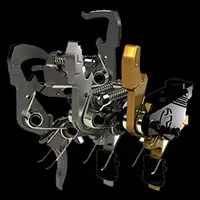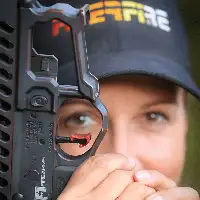“Necessity is the mother of invention.” We can’t say why others didn’t see the need. But we did, and developed something novel and useful to meet it. The need: improve finger dexterity and tactile feedback in a trigger for the most demanding shooter, the 3*gun competitor, where high accuracy and fast splits are of paramount importance. Of course you don’t have to be a 3*gunner to appreciate what advantage it could bring to your shooting style.
When the shooter pulls the trigger, the finger moves first. When the finger pad can no longer compress, the trigger begins to move. The amount of finger pad compression is directly related to trigger weight. If the weight is high, the pad compresses more compared to a lighter weighted trigger. Some high-end triggers have a very narrow trigger bow. In those cases, even though the weight is low, the depression produced in the finger pad due to the smaller contact area compared to the normally sized trigger bow’s width. This causes a similar delay in the onset of trigger movement as does a high weight trigger. See? Weight is not the only factor that affects trigger responsiveness. An improvement in the trigger’s responsiveness to our trigger finger is our objective!
One more point before we get to the shoe. The 24C’s trigger bow is straight. Without the shoe, this results in slightly more compression of the finger pad flesh given the same trigger bow width, the same trigger weight, and the same lever arm length (distance of finger pad placement relative to the trigger pivot) than the conventionally curved bow, because it conforms less to the finger pad’s natural curvature. This results in relatively more finger pad compression than the traditionally curved bow. This also explains why every shooter’s experience with a given trigger can be different, because everyone’s trigger finger pad is different, compressing more or less according to their physiology. What the straight bow does provide and that’s why its so attractive to many is that the shooter can modify finger placement and therefore vary slightly the trigger’s creep and weight by adjusting the lever arm length to suit his taste. Of course, this is all the more attractive since the 24C has three different user adjustable weights to begin with, which makes the range of adjustment almost continuous.
Well, using the shoe on the trigger accomplishes two things: first, it increases the trigger finger pad’s surface contact area, which for a given trigger weight, lowers the force exerted by the finger pad necessary to initiate trigger movement. The result is that the trigger “feels” and indeed is more responsive to trigger finger displacement, which translates into a more trigger tactile feedback sensitivity that can enhance performance speed and timing. And by the way, adding the shoe is the only way to make an AR15 trigger wider without opening up the trigger slot in the lower receiver. Second, because the HIPERSHOE®’s position can be indexed to specific locations on the straight trigger bow, the shooter has repeatable control over the placement of his trigger finger. By adjusting the shoe up or down, he can not only fine-tune creep and weight, but absolutely control finger position relative to the grip he’s using for comfort or other reasons. For those reasons we developed the HIPERSHOE® HIgh PERformance SHOE.















